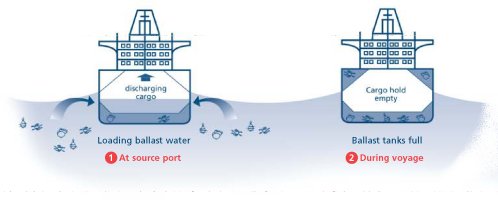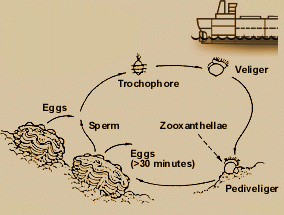|
The introduction of invasive marine species
into new environments by ships’ ballast water, attached to ships’
hulls and via other vectors has been identified as one of the
four greatest threats to the world’s oceans. The other three
are land-based sources of marine pollution, overexploitation
of living marine resources and physical alteration/destruction
of marine habitat.
Shipping moves over 80% of the world’s commodities and transfers
approximately 3 to 5 billion tonnes of ballast water internationally
each year. A similar volume may also be transferred domestically
within countries and regions each year. Ballast water is absolutely
essential to the safe and efficient operation of modern shipping,
providing balance and stability to un-laden ships. However,
it may also pose a serious ecological, economic and health threat.
|

|
|
What is ballast water?
|
|
Ballast is any material used to weight and/or balance
an object. One example is the sandbags carried on conventional
hot-air balloons, which can be discarded to lighten the
balloon’s load, allowing it to ascend. Ballast water is
therefore water carried by ships to ensure stability,
trim and structural integrity.
|
|
|
Ships have carried solid ballast, in the form of rocks, sand
or metal, for thousands of years. In modern times, ships use
water as ballast.
It is much easier to load on and off a ship, and is therefore
more efficient and economical than solid ballast. When a ship
is empty of cargo, it fills with ballast water. When it loads
cargo, the ballast water is discharged.
|
Cross section of ships
showing ballast tanks and ballast water cycle
|


Representative Ballast Capacities
| VESSEL TYPE |
DWT
|
BALLAST CONDITION
|
|
NORMAL
(tonnes)
|
% of DWT
|
HEAVY
(tonnes)
|
% of DWT
|
| |
|
| Bulk carrier |
250,000
|
75,000
|
30
|
113,000
|
45
|
| Bulk carrier |
150,000
|
45,000
|
30
|
67,000
|
45
|
| Bulk carrier |
70,000
|
25,000
|
36
|
40,000
|
57
|
| Bulk carrier |
35,000
|
10,000
|
30
|
17,000
|
49
|
| |
|
|
|
|
|
| Tanker |
100,000
|
40,000
|
40
|
45,000
|
45
|
| Tanker |
40,000
|
12,000
|
30
|
15,000
|
38
|
| |
|
|
|
|
|
| Container |
40,000
|
12,000
|
30
|
15,000
|
38
|
| Container |
15,000
|
5,000
|
30
|
n/a
|
|
| |
|
|
|
|
|
| General cargo |
17,000
|
6,000
|
35
|
n/a
|
|
| General cargo |
8,000
|
3,000
|
38
|
n/a
|
|
| |
|
|
|
|
|
| Passenger/RORO |
3,000
|
1,000
|
33
|
n/a
|
|
| |
|
|
|
|
|
The distribution of ballast within a vessel will
depend on the design criteria, size and strength of the vessel.
Source: Australian Quarantine & Inspection Service 1993.
Ballast Water Management. Ballast Water Research Series Report
No. 4 AGPS Canberra.
A potentially serious environmental problem arises
when this ballast water contains marine life.
There are thousands of marine species that may be carried in
ships’ ballast water; basically anything that is small enough
to pass through a ships’ ballast water intake ports and pumps.
|
|
These include bacteria and other microbes,
small invertebrates and the eggs, cysts and larvae of
various species.
The problem is compounded by the fact
that virtually all marine species have life cycles that
include a planktonic stage or stages.
Even species in which the adults are
unlikely to be taken on in ballast water, for example
because they are too large or live attached to the seabed,
may be transferred in ballast during their planktonic
phase.
|

Clam life cycle
|
|

Prawn life cycle
|
|
|
Over the past millennia, marine species have dispersed throughout
the oceans by natural means, carried on currents and attached
to floating logs and debris.
Natural barriers, such as temperature and land masses, have
prevented many species from dispersing into certain areas. This
has resulted in the natural patterns of biogeography observed
in the oceans today.
In particular, the pan-global tropical zone
has separated the northern and southern temperate and cold water
zones. This has allowed many species to evolve quite independently
in these latter zones, resulting in quite different marine biodiversity
between the north and the south.
In tropical areas species have not faced the same barriers.
This is exemplified by the relatively homogenous marine biodiversity
spanning the huge area of the Indo-Pacific, from the east coast
of Africa to the west coast of South America.
|
An example of marine biogeography/biodiversity contours.

Humans have of course aided this process for as long as they have sailed,
mainly by dispersing marine species that have attached to the hulls
of vessels. The commencement of the use water as ballast, and the development
of larger, faster ships completing their voyages in ever shorter times,
combined with rapidly increasing world trade, means that the natural
barriers to the dispersal of species across the oceans are being reduced.
In particular, ships provide a way for temperate marine species to pierce
the tropical zones, and some of the most spectacular introductions have
involved northern temperate species invading southern temperate waters,
and vice versa.
It is estimated that at least 7,000 different species are being carried
in ships’ ballast tanks around the world. The vast majority of marine
species carried in ballast water do not survive the journey, as the
ballasting and deballasting cycle and the environment inside ballast
tanks can be quite hostile to organism survival. Even for those that
do survive a voyage and are discharged, the chances of surviving in
the new environmental conditions, including predation by and/or competition
from native species, are further reduced. However, when all factors
are favourable, an introduced species by survive to establish a reproductive
population in the host environment, it may even become invasive, out-competing
native species and multiplying into pest proportions.
As a result, whole ecosystems are being changed. In the USA, the European
Zebra Mussel Dreissena polymorpha has infested over 40% of internal
waterways and may have required between US$750 million and US$1 billion
in expenditure on control measures between 1989 and 2000. In southern
Australia, the Asian kelp Undaria pinnatifida is invading new
areas rapidly, displacing the native seabed communities. In the Black
Sea, the filter-feeding North American jellyfish Mnemiopsis leidyi
has on occasion reached densities of 1kg of biomass per m2. It has depleted
native plankton stocks to such an extent that it has contributed to
the collapse of entire Black Sea commercial fisheries. In several countries,
introduced, microscopic, ‘red-tide’ algae (toxic dinoflagellates) have
been absorbed by filter-feeding shellfish, such as oysters. When eaten
by humans, these contaminated shellfish can cause paralysis and even
death. The list goes on, hundreds of examples of major ecological, economic
and human health impacts across the globe. It is even feared that diseases
such as cholera might be able to be transported in ballast water.
There are hundreds of other examples of catastrophic introductions around
the world, causing severe human health, economic and/or ecological impacts
in their host environments.
Invasive marine species are one of the four greatest
threats to the world’s oceans! Unlike other forms of marine pollution,
such as oil spills, where ameliorative action can be taken and from
which the environment will eventually recover, the impacts of invasive
marine species are most often irreversible!
|




